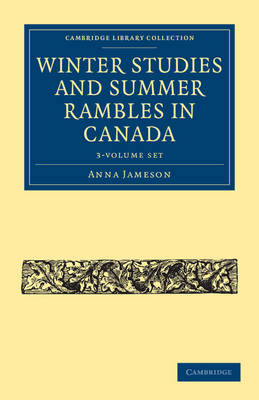Cambridge Library Collection - North American History
2 primary works • 4 total works
Volume 1
Anna Jameson (1794-1860) was an inspirational figure to a generation of young women writers and artists including Barbara Bodichon and Bessie Rayner Parkes. Her work was reviewed by leading figures such as Mary Shelley and Charles Kingsley, and even Thomas Carlyle, though less complimentary, referred to her as the 'celebrated Mrs Jamieson'. This book, first published in 1838, secured her growing reputation as a writer of history, literary criticism and travel literature, and has been popular ever since. Inspired by a journey made to support the career of her estranged husband, one of its key themes is the condition of women, which recurs regularly in Jameson's writing. In Volume 1, Jameson describes her difficulty adapting to the winter cold, her impressions of Ontario's landscape, peoples, and political system, and her reflections on literature, especially Goethe. For more information on this author, see http://orlando.cambridge.org/public/svPeople?person_id=jamean
Volume 2
Anna Jameson (1794-1860) was an inspirational figure to a generation of young women writers and artists including Barbara Bodichon and Bessie Rayner Parkes. Her work was reviewed by leading figures such as Mary Shelley and Charles Kingsley, and even Carlyle, though less complimentary, referred to her as the 'celebrated Mrs Jamieson'. This book, first published in 1838, secured her growing reputation as a writer of history, literary criticism and travel literature, and has been popular ever since. Inspired by a journey made to support the career of her estranged husband, one of its key themes is the condition of women, which recurs regularly in Jameson's writing. Volume 2 describes the arrival of summer, and Jameson's experiences of landscapes, towns and people from Niagara to Detroit. It includes reflections on Schiller, emigration, and the Canadian infrastructure. For more information on this author, see http://orlando.cambridge.org/public/svPeople?person_id=jamean
Anna Jameson (1794-1860) was an inspirational figure to a generation of young women writers and artists including Barbara Bodichon and Bessie Rayner Parkes. Her work was reviewed by leading figures such as Mary Shelley and Charles Kingsley, and even Thomas Carlyle, though less complimentary, referred to her as the 'celebrated Mrs Jamieson'. This book, first published in 1838, secured her already growing reputation as a writer of history, literary criticism and travel literature, and has been popular ever since. Inspired by a journey made to support the career of her estranged husband, one of its key themes is the condition of women, which recurs regularly in Jameson's writing. Volume 3 centres on a journey up Lake Huron and describes Native American settlements, languages, customs, and beliefs, revealing her ambivalent feelings of both curiosity and revulsion. For more information on this author, see http://orlando.cambridge.org/public/svPeople?person_id=jamean
Winter Studies and Summer Rambles in Canada 3 Volume Paperback Set
by Anna Jameson
Published 3 November 2011
Anna Jameson (1794-1860) was an inspirational figure to a generation of young women writers and artists including Barbara Bodichon and Bessie Rayner Parkes. Her work was reviewed by leading figures such as Mary Shelley and Charles Kingsley, and even Thomas Carlyle, though less complimentary, referred to her as the 'celebrated Mrs Jamieson'. This book, first published in 1838, secured her growing reputation as a writer of history, literary criticism and travel literature, and has been popular ever since. Inspired by a journey made to support the career of her estranged husband, one of its key themes is the condition of women, which recurs regularly in Jameson's writing. Her three-volume account of the Great Lakes region records her impressions of the weather, landscape, society and indigenous peoples, and includes literary reflections, particularly on the German Romantics. For more information on this author, see http://orlando.cambridge.org/public/svPeople?person_id=jamean

